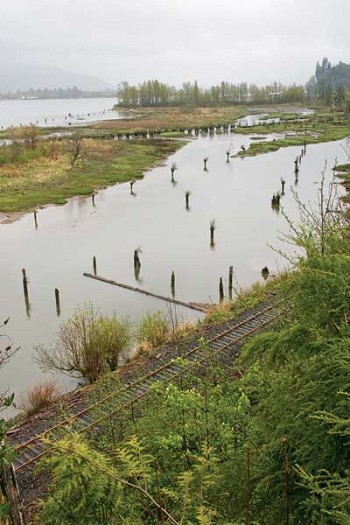forum
library
tutorial
contact

Letter: Bradwood to Enhance Salmon
by Gary CoppedgeThe Daily Astorian, November 21, 2008
|
the film forum library tutorial contact |

|
Letter: Bradwood to Enhance Salmon
by Gary CoppedgeThe Daily Astorian, November 21, 2008 |
 The Daily Astorian's article ("LNG is on path of fish sanctuary," Nov. 3) and subsequent editorial ("Should we trash salmon for LNG," Nov. 4) on Bradwood Landing's alleged impacts to Clifton channel completely missed the mark. When looking at the facts, it's easy to understand why.
The Daily Astorian's article ("LNG is on path of fish sanctuary," Nov. 3) and subsequent editorial ("Should we trash salmon for LNG," Nov. 4) on Bradwood Landing's alleged impacts to Clifton channel completely missed the mark. When looking at the facts, it's easy to understand why.
First, the Bradwood site isn't located in Clifton Channel. It is located upstream in the Columbia River. Because it has a natural deep-water channel close to shore, Bradwood is an ideal location for a port, which explains why the site was used for that purpose during the past 150 years. Further, neither the project's construction nor operations, including dredging, would take place in the channel.
Scientific studies have shown that dredging impacts would be minimal. Because of the deep water at Bradwood, dredging for the turning basin would begin in water that is already more than 20 feet deep. In fact, most will occur in water below a depth of 30 feet - well beneath the surface waters typically used by juvenile salmon.
Deep water areas will be made deeper, but their habitat function will not change. There also will be no significant impact to shallow water habitat, other than the filling of an old, man-made mill log pond on the site.
Extensive hydrodynamic analysis shows that Bradwood Landing will have no significant effect on river flow and sediment movement in Clifton Channel, and there is no significant science to the contrary. Unfortunately, both the article and the editorial ignore this evidence.
Instead, the information cited by The Daily Astorian is from limited sampling at a single location in Clifton Channel. Similar sampling at several other locations in the lower Columbia showed approximately the same numbers of juvenile salmon. Indeed, with more than 100 million juvenile salmon moving through the Columbia River Estuary every year (most of which are from hatcheries) it would be surprising if there were not fish in this location as well as many others.
What's more, there is no official designation to suggest that Clifton Channel is a "sanctuary." It is misleading unless you consider all lower velocity, shoreline habitat throughout the entire estuary to be a sanctuary.
Bradwood represents a new model of sustainable industrial development. Our proposed mitigation is robust and exceeds all regulatory requirements. And we are pioneering the use of screened water intakes to protect fish. This proposal - designed to avoid entrainment of juvenile salmon into ship ballast and cooling systems - will be the first of its kind on the Columbia and will meet unprecedented fish protection standards. Furthermore, the $59 million committed for our Salmon Enhancement Initiative is the largest private contribution to improving the lower Columbia River. The SEI is a voluntary program that goes far above any state or federal requirements and will be a binding condition of Bradwood's approval.
Using the National Marine Fisheries Service's own methodology, conservative estimates show that Bradwood's SEI could increase downstream migrant salmon survival and put 1.77 million more juvenile fish into the ocean each year. By providing private funding to groups already engaged in watershed restoration efforts, the SEI would allow those groups to claim federal and state match dollars that currently go unclaimed. This is a win-win for everyone, and most importantly, for salmon recovery and overall ecosystem health.
A huge body of technical information and analysis was made available in the revised draft Biological Assessment that NorthernStar recently submitted to the Federal Energy Regulatory Commission that addresses these issues. It is available to the public on the FERC Web site. This factual information should be the basis for conclusions and decisions on the project, and not selected reports that do not provide context as to how impacts will be offset. The Daily Astorian does its readers a disservice by failing again to present information that runs counter to their viewpoint.
learn more on topics covered in the film
see the video
read the script
learn the songs
discussion forum
